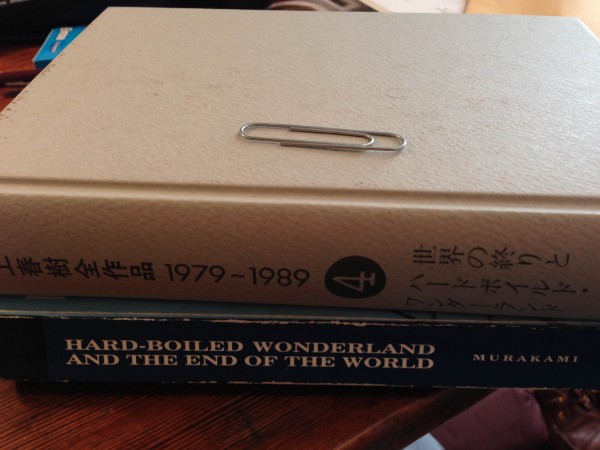Belated post to account for pages 45-55, which I completed in a single reading last weekend. I’ll be focusing on the English this time around and some of Murakami’s narrative techniques.
Still in Chapter 3 with Watashi making his way to the laboratory and working with the old man. This is a very long chapter, especially in comparison with the first two chapters. Chapter 1 is 11 pages in translation but perhaps feels longer because of all the waiting and thinking involved – we’re in Watashi’s head the whole time. Chapter 2 is a scant six pages, but it has great images, concisely establishes tension with the Gatekeeper, and is effectively the inverse of Chapter 1: while Chapter 1 focuses on Watashi’s inner thoughts, Chapter 2 has almost no response from Boku to his surroundings, no interiority.
I think this is a really good strategy for the beginning of the book. The short chapters help the reader feel like they are moving at a good pace, and the interiority or lack thereof sets up themes that Murakami will cash in on later. The concision of Chapter 2 also does an amazing job of creating an air of mystery – through specificity of detail and not through vagueness – and generates an incredible desire to spend more time in this world.
It makes sense, then, that Chapter 3 is longer. As a readers, we’ve now been primed and are ready to get through material to jump between worlds and learn more about both (and experience the different pleasures that each offers). Murakami can now take his time and give the details about the System and the Factory, Semiotecs and Calcutecs, etc. and we will put up with it. Had he frontloaded this information, it might not have gone down so easily. (This is probably a technique Murakami should have considered for 1Q84.)
In Chapter 3, Murakami also makes effective use of gesture, which he often gets criticized for in other works (temple rubbing, etc). In this case Murakami uses gesture to characterize the old man:
The old man looked me over. Then he picked up a paperclip and unbent it to scrape at a fingernail cuticle. His left index finger cuticle. When he’d finished with the cuticle, he discarded the straightened paperclip into the ashtray. If I ever get reincarnated, it occurred to me, let me make certain I don’t come back as a paperclip. (26)
This makes great use of the paperclip, which will recur throughout the story, and characterizes the old man as unthinking in the way he treats the paperclip. Murakami brings it up once more briefly in these ten pages, but it doesn’t feel overused. I’ll be keeping an eye on this for the rest of the chapter, which is just another three pages.
And a bit o the Japanese since I can’t help myself. The last line is an interesting translation by Birnbaum, but I think he does the Japanese justice:
わけのわからない老人の爪の甘皮を押し戻してそのまま灰皿に捨てられてしまうなんて、あまりぞっとしない。
Murakami does put Watashi into the mindset of the paperclip with the adversative passive, which I think corresponds not indelicately in the English version as I considers being reincarnated.
That phrase ぞっとしない is confusing even to Japanese people, apparently, and the Internets sez it was invented by Soseki himself. Not bad, eh?


I dunno, man, that answer #6 is confusingly written and I don’t think its explanation makes sense. Answer #5 accords much more closely with my understanding: ぞっと used to be a more general way of describing a physical reaction (chills, etc.) to something, whether due to fear, awe, amazement, etc., and so ぞっとしない is essentially a laconic “meh”. (Also, to be really anal it just says that Soseki popularized it… which may be true, but I’d want to see some more evidence, given that it was in rakugo and kabuki and so on years earlier. I’ve run into a few “Soseki invented X” stories before and they inevitably turned out not be true — it’s just that they date from a time before internet searching made it easy to find citations that antedate him.)
Re the translation, that is a bold approach. I don’t know how I feel about it. Reincarnation is a pretty big concept to add on your own initiative, and it seems that I has gone from “I can imagine that and it doesn’t sound so great” from “I’d better keep myself from falling into THAT position”, which makes him just a hair more of a jerk IMO.
Yeah, I figured the Soseki thing was suspicious at best, but it was funny to see that. My first encounter with one of those.
As for adding the reincarnation bit, I think I’m cool with it, although I do wonder if readers associated that with a particularly Japanese way of thinking. That was something I hadn’t considered. I read it as sarcastic, which I think does reflect the Japanese, which I’m about to look at in a new post…